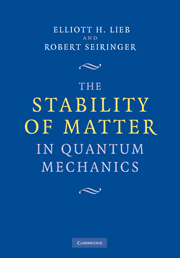Book contents
- Frontmatter
- Contents
- Preface
- 1 Prologue
- 2 Introduction to Elementary Quantum Mechanics and Stability of the First Kind
- 3 Many-Particle Systems and Stability of the Second Kind
- 4 Lieb–Thirring and Related Inequalities
- 5 Electrostatic Inequalities
- 6 An Estimation of the Indirect Part of the Coulomb Energy
- 7 Stability of Non-Relativistic Matter
- 8 Stability of Relativistic Matter
- 9 Magnetic Fields and the Pauli Operator
- 10 The Dirac Operator and the Brown–Ravenhall Model
- 11 Quantized Electromagnetic Fields and Stability of Matter
- 12 The Ionization Problem, and the Dependence of the Energy on N and M Separately
- 13 Gravitational Stability of White Dwarfs and Neutron Stars
- 14 The Thermodynamic Limit for Coulomb Systems
- List of Symbols
- Bibliography
- Index
4 - Lieb–Thirring and Related Inequalities
Published online by Cambridge University Press: 20 December 2010
- Frontmatter
- Contents
- Preface
- 1 Prologue
- 2 Introduction to Elementary Quantum Mechanics and Stability of the First Kind
- 3 Many-Particle Systems and Stability of the Second Kind
- 4 Lieb–Thirring and Related Inequalities
- 5 Electrostatic Inequalities
- 6 An Estimation of the Indirect Part of the Coulomb Energy
- 7 Stability of Non-Relativistic Matter
- 8 Stability of Relativistic Matter
- 9 Magnetic Fields and the Pauli Operator
- 10 The Dirac Operator and the Brown–Ravenhall Model
- 11 Quantized Electromagnetic Fields and Stability of Matter
- 12 The Ionization Problem, and the Dependence of the Energy on N and M Separately
- 13 Gravitational Stability of White Dwarfs and Neutron Stars
- 14 The Thermodynamic Limit for Coulomb Systems
- List of Symbols
- Bibliography
- Index
Summary
LT Inequalities: Formulation
The non-relativistic versions of the inequalities discussed in this chapter were invented in 1975 in order to give an alternative, simpler proof of the stability of non-relativistic matter, first proved by Dyson and Lenard. The basic idea, as we said in Section 1.1, was to relate the stability of quantum-mechanical Coulomb systems to the simpler Thomas-Fermi theory of Coulomb systems, which was known to have the required stability properties.
These inequalities have many extensions and a sizable literature, and are collectively known as Lieb-Thirring (LT) inequalities. While we do not follow the Thomas-Fermi route to stability in this book, for reasons explained earlier, the inequalities will, nevertheless, play an essential role in various aspects of the relativistic and non-relativistic theories.
In this introduction we shall explain the various inequalities. The next section gives their connection with kinetic energy inequalities, which was the original 1975 motivation. The rest of the chapter is devoted to proofs and can be skipped by anyone interested only in applications. The proofs require a theorem about traces of operators, which is given in an appendix to this chapter. The proofs given here follow closely the discussion in, except for the theorem in the appendix to this chapter, which is only stated but not proved in.
- Type
- Chapter
- Information
- The Stability of Matter in Quantum Mechanics , pp. 62 - 88Publisher: Cambridge University PressPrint publication year: 2009



